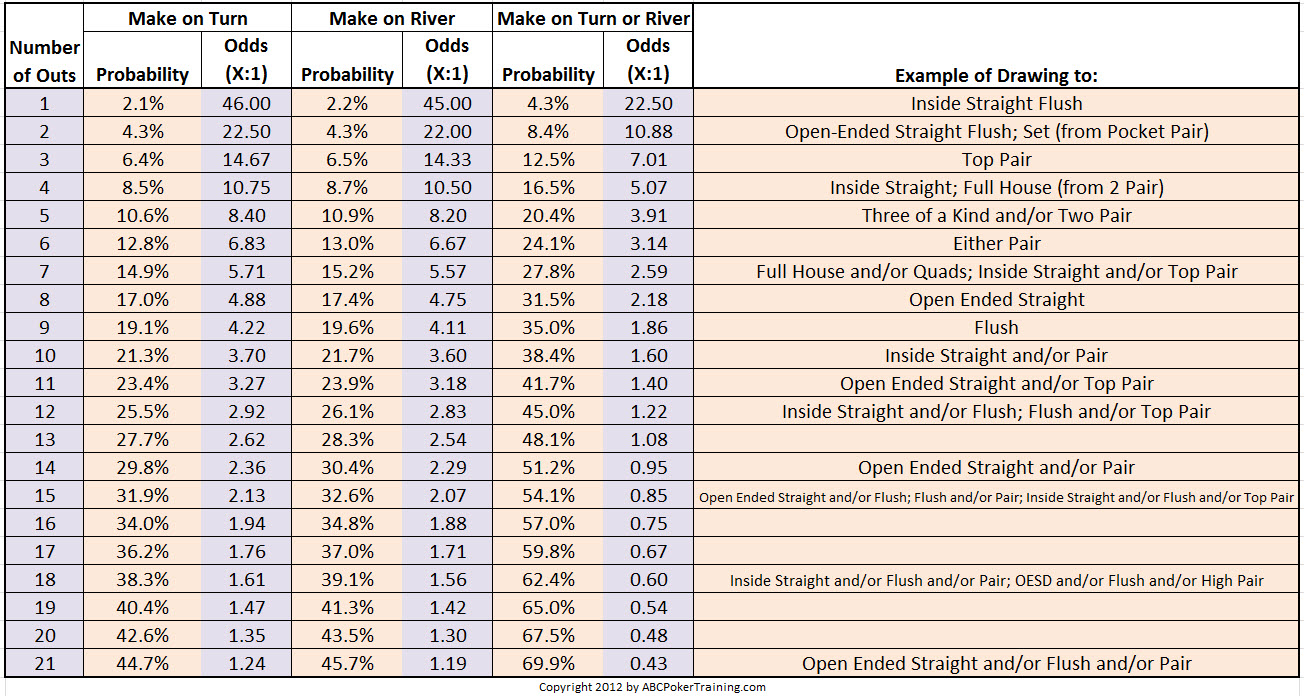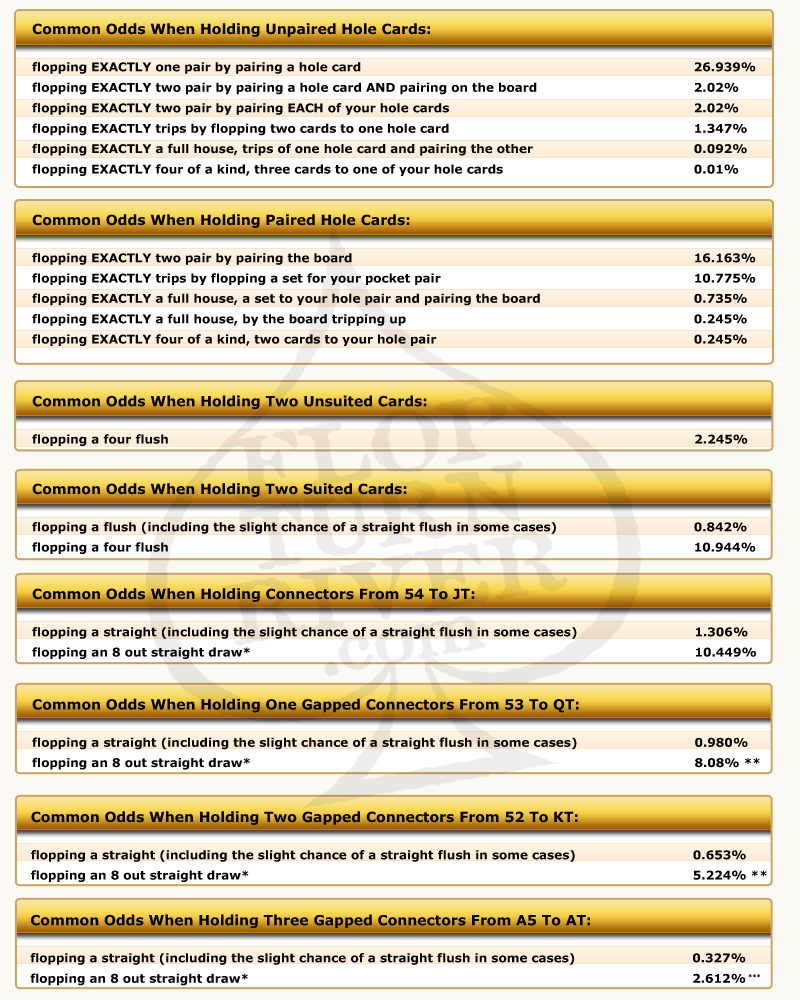Poker Counting Odds And Outs
- Poker Counting Odds And Outs Games
- Poker Counting Odds And Outs Game
- Poker Counting Odds And Outs Practice
- Poker Counting Odds And Outs Printable
Count Your Outs - How Not to Suck at Poker Ep. 3 - Duration: 2:57. PokerListings 137,088 views. How To Use Pot Odds In Poker Poker Quick Plays - Duration: 5:00.
- Follow these simple steps at certain stages to calculate odds: After the flop, multiple your outs by 2 for odds to hit a draw on the turn. After the turn, multiple your outs by 2 for odds to hit a draw on the river. If an opponent goes all-in after the flop, multiply your outs by 4 for odds to hit a.
- Poker odds calculate the chances of you holding a winning hand. The poker odds calculators on CardPlayer.com let you run any scenario that you see at the poker table, see your odds and outs,.
Once the flop has been dealt in Texas Hold'em, you'll be able to count your outs and know how likely it is your hand will improve. That will tell you whether you should stay in the hand or fold.
You can figure out your outs and odds for any hand, but here is a quick and dirty list of the most common scenarios:
Poker Counting Odds And Outs Games
Texas Hold'em Cheat SheetOdds Based on Outs after the Flop
If after the flop, you have:
Two outs: Your odds are 11 to 1 (about 8.5 percent)
A common scenario would be when you have a pair and you are hoping your pair becomes a three-of-a-kind (a set).
Four outs: Your odds are 5 to 1 (about 16.5 percent)
A common scenario would be when you are trying to hit an inside straight draw (there are 4 cards of one number that will complete the straight) or you have two pairs and you hope to make a full house (there are three cards remaining of one number and two of the other).
Eight outs: Your odds are 2 to 1 (about 31 percent)
A common scenario would be that you have an open-ended straight draw. There are four remaining cards of two different numbers that will complete your straight, on the high end and on the low end.
Nine outs: Your odds are 2 to 1 (about 35 percent)
This is the common scenario when you have a flush draw. Any of the nine remaining cards of the suit will give you a flush.
Fifteen outs: Your odds are 1 to 1 (about 54 percent)
A scenario for this is having a straight and flush draw, where either any of the nine remaining cards of the suit will give you a flush, while there are four cards remaining of each of two numbers that would complete a straight. However, you don't count the same cards twice as outs, so those of suit you hope to get don't count again.
The Rule of Four and Two
These odds only apply to counting both the turn and the river, so they assume you will stay in the hand until the showdown. Your odds are only about half as good for a single card draw, such taking the hit on the turn or taking the hit on the river. A common way of looking at the difference in the odds when you will be seeing two cards compared with one is called the Rule of 4 and 2.
After the flop, count your outs and multiply them by four to get your percentage odds. This doesn't give you an exact number, but it is quickly in the ballpark. With 15 outs, 4 x 15 = 55 percent you'll complete that straight or flush with the next two draws.

However, when you are calculating the odds that a single draw will improve your hand, you multiply the outs by two rather than 4. With 15 outs, 2 x 15 = 30 percent chance.
Poker Outs to Odds
To find your chance of improving a drawing hand based on the number of outs, use the following table:| Outs | Turn Odds | River Odds | Turn+River Odds |
| 1 Out | 45.9-to-1 (2.13%) | 45.1-to-1 (2.17%) | 22.3-to-1 (4.26%) |
| 2 Outs | 22.5-to-1 (4.26%) | 22.0-to-1 (4.35%) | 10.9-to-1 (8.42%) |
| 3 Outs | 14.7-to-1 (6.38%) | 14.3-to-1 (6.52%) | 7.0-to-1 (12.49)% |
| 4 Outs | 10.8-to-1 (8.51%) | 10.5-to-1 (8.70%) | 5.1-to-1 (16.47%) |
| 5 Outs | 8.4-to-1 (10.64%) | 8.2-to-1 (10.87%) | 3.9-to-1 (20.35%) |
| 6 Outs | 6.8-to-1 (12.77%) | 6.7-to-1 (13.04%) | 3.2-to-1 (24.14%) |
| 7 Outs | 5.7-to-1 (14.89%) | 5.6-to-1 (15.22%) | 2.6-to-1 (27.84%) |
| 8 Outs | 4.9-to-1 (17.02%) | 4.8-to-1 (17.39%) | 2.2-to-1 (31.45%) |
| 9 Outs | 4.2-to-1 (19.15%) | 4.1-to-1 (19.57%) | 1.9-to-1 (34.97%) |
| 10 Outs | 3.7-to-1 (21.28%) | 3.6-to-1 (21.74%) | 1.6-to-1 (38.39%) |
| 11 Outs | 3.3-to-1 (23.40%) | 3.2-to-1 (23.91%) | 1.4-to-1 (41.72%) |
| 12 Outs | 2.9-to-1 (25.53%) | 2.8-to-1 (26.09%) | 1.2-to-1 (44.96%) |
| 13 Outs | 2.6-to-1 (27.66%) | 2.5-to-1 (28.26%) | 1.1-to-1 (48.10%) |
| 14 Outs | 2.4-to-1 (29.79%) | 2.3-to-1 (30.43%) | 0.95-to-1 (51.16%) |
| 15 Outs | 2.1-to-1 (31.91%) | 2.1-to-1 (32.61%) | 0.85-to-1 (54.12%) |
| 16 Outs | 1.9-to-1 (34.04%) | 1.9-to-1 (34.78%) | 0.75-to-1 (56.98%) |
| 17 Outs | 1.8-to-1 (36.17%) | 1.7-to-1 (36.96%) | 0.67-to-1 (59.76%) |
| 18 Outs | 1.6-to-1 (38.30%) | 1.6-to-1 (39.13%) | 0.60-to-1 (62.44%) |
| 19 Outs | 1.5-to-1 (40.43%) | 1.4-to-1 (41.30%) | 0.54-to-1 (65.03%) |
| 20 Outs | 1.3-to-1 (42.55%) | 1.3-to-1 (43.48%) | 0.48-to-1 (67.53%) |
| 21 Outs | 1.2-to-1 (44.68%) | 1.2-to-1 (45.65%) | 0.43-to-1 (69.94%) |
| 22 Outs | 1.1-to-1 (46.81%) | 1.1-to-1 (47.83%) | 0.38-to-1 (72.25%) |
Poker Counting Odds And Outs Game
| Accuracy | Turn | River | Turn+River | Comments |
| Excellent | Outs times 2.13% | Outs times 2.17% | *Turn odds plus River odds minus Turn odds times River odds | More accurate than you'll ever need |
| Very Good | Outs times 2-1/8% | Outs times 2-1/6% | **Outs times 4%, minus (Outs - 8) if 9 or more Outs | As accurate as you'll ever need |
| Good | Outs times 2%, plus 1% if 5+ Outs, plus 2% if 13+ Outs | Same as Turn | **Outs times 4%, minus (Outs - 8) if 9 or more Outs | The easiest reasonable approximation |
| Bad | Outs times 2% plus 1% | Same as Turn | Outs times 4% | Not good if low or high numbers of outs |
* For example, using the Good approximation, if you have 9 Outs, then you have a 19% chance on the turn, a 19% chance on the river, and a 38% minus 19% of 19% (close to 20% of 20%, which is 4%) equals a 34% chance on the turn and river combined.
Poker Counting Odds And Outs Practice
** From David Solomon, mentioned in Harrington on Hold 'em: Volume 2.
